Vegetable: Difference between revisions
No edit summary |
No edit summary |
||
| Line 73: | Line 73: | ||
:: [[green bean]]s, [[lentil]]s, [[snow pea]]s, [[soybean]] |
:: [[green bean]]s, [[lentil]]s, [[snow pea]]s, [[soybean]] |
||
* [[Pizza]] |
* [[Pizza]] |
||
* [[ |
* [[Mcdonalds]] |
||
==Nutrition== |
==Nutrition== |
||
Revision as of 03:51, 22 March 2012
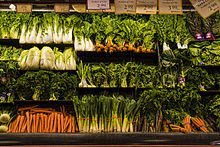
The noun vegetable means an edible plant or part of a plant, but usually excludes seeds and most sweet fruit. This typically means the leaf, stem, or root of a plant.
In a non-biological sense, the meaning of this word is largely based on culinary and cultural tradition. Therefore, the application of the word is somewhat arbitrary and subjective. For example, some people consider mushrooms to be vegetables even though they are not biologically plants,[1][2] while others consider them a separate food category.[3]
Some vegetables can be consumed raw, some may be eaten cooked, and some must be cooked in order to be edible. Vegetables are most often cooked in savory or salty dishes. However, a few vegetables are often used in desserts and other sweet dishes, such as rhubarb pie and carrot cake. A number of processed food items available on the market contain vegetable ingredients and can be referred to as "vegetable derived" products. These products may or may not maintain the nutritional integrity of the vegetable used to produce them. Examples of vegetable-derived products are ketchup, tomato sauce, and vegetable oils.
Etymology
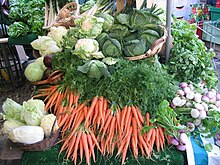

"Vegetable" comes from the Latin vegetabilis (animated) and from vegetare (enliven), which is derived from vegetus (active), in reference to the process of a plant growing.
The word "vegetable" was first recorded in English in the 15th century,[4] and originally applied to any plant. This is still the sense of the adjective "vegetable" in biological context.[5] In 1967, the meaning of the term "vegetable" was specified to mean "plant cultivated for food, edible herb or root." The year 1955 noted the first use of the shortened, slang term "veggie". [6]
As an adjective, the word vegetable is used in scientific and technical contexts with a different and much broader meaning, namely of "related to plants" in general, edible or not — as in vegetable matter, vegetable kingdom, vegetable origin, etc.[5] The meaning of "vegetable" as "plant grown for food" was not established until the 18th century.[7]
Terminology

There are at least four definitions relating to fruits and vegetables:
- Fruit (botany): the ovary of a flowering plant (sometimes including accessory structures),
- Fruit (culinary): any edible part of a plant with a sweet flavor,
- Vegetable: any edible part of a plant with a savory flavor.
- Vegetable (legal): commodities that are taxed as vegetables in a particular jurisdiction
In everyday, grocery-store, culinary language, the words "fruit" and "vegetable" are mutually exclusive; plant products that are called fruit are hardly ever classified as vegetables, and vice-versa. The word "fruit" has a precise botanical meaning (a part that developed from the ovary of a flowering plant), which is considerably different from its culinary meaning, and includes many poisonous fruits. While peaches, plums, and oranges are "fruit" in both senses, many items commonly called "vegetables" — such as eggplants, bell peppers, and tomatoes — are botanically fruits, while the cereals (grains) are both a fruit and a vegetable, as well as some spices like black pepper and chili peppers. Some plant products, such as corn or peas, may be considered to be vegetables only while still unripe.
The question of whether the tomato is a fruit or a vegetable found its way into the United States Supreme Court in 1893. The court ruled unanimously in Nix v. Hedden that a tomato is correctly identified as, and thus taxed as, a vegetable, for the purposes of the Tariff of 1883 on imported produce. The court did acknowledge, however, that, botanically speaking, a tomato is a fruit.[8]
Languages other than English often have categories that can be identified with the common English meanings of "fruit" and "vegetable", but their precise meaning often depends on local culinary traditions. For example, in Brazil the avocado is traditionally consumed with sugar as a dessert or in milkshakes, and hence it is regarded as a culinary fruit; whereas in other countries (including Mexico and the United States) it is used in salads and dips, and hence considered to be a vegetable.[citation needed]
Examples of different parts of plants used as vegetables
The list of food items called "vegetable" is quite long, and includes many different parts of plants:
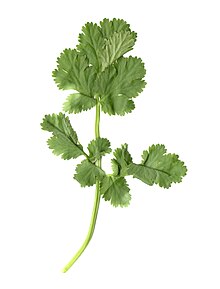
- Flower bud
- Seeds
- Sweet corn (maize), peas, beans
- kale, collard greens, spinach, arugula, beet greens, bok choy, chard, choi sum, turnip greens, endive, lettuce, mustard greens, watercress, garlic chives, gai lan
- Leaf sheaths
- Whole-plant sprouts
- soybean (moyashi), mung beans, urad, and alfalfa.
- Fruits in the botanical sense, but used as vegetables
- tomatoes, cucumbers, squash, zucchinis, pumpkins, peppers, eggplant, tomatillos, christophene, okra, breadfruit and avocado, and also the following:
Nutrition
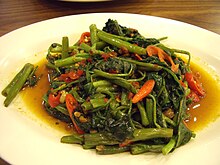
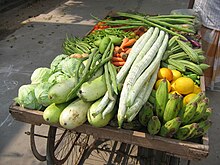
Vegetables are eaten in a variety of ways, as part of main meals and as snacks. The nutritional content of vegetables varies considerably, though generally they contain little protein or fat,[9][10] and varying proportions of vitamins such as Vitamin A, Vitamin K and Vitamin B6, provitamins, dietary minerals and carbohydrates. Vegetables contain a great variety of other phytochemicals, some of which have been claimed to have antioxidant, antibacterial, antifungal, antiviral and anticarcinogenic properties.[11][12] Some vegetables also contain fiber important for GI function. Vegetables contain important nutrients necessary for healthy hair and skin as well. A person who refrains from dairy and meat products, and eats only plants (including vegetables) is known as a vegan.
However, vegetables often also contain toxins and antinutrients such as α-solanine, α-chaconine,[13] enzyme inhibitors (of cholinesterase, protease, amylase, etc.), cyanide and cyanide precursors, oxalic acid, and more.[14] Depending on the concentration, such compounds may reduce the edibility, nutritional value, and health benefits of dietary vegetables. Cooking and/or other processing may be necessary to eliminate or reduce them.
Diets containing recommended amounts of fruits and vegetables may help lower the risk of heart diseases and type 2 diabetes. These diets may also protect against some cancers and decrease bone loss. The potassium provided by both fruits and vegetables may help prevent the formation of kidney stones.
Dietary Recommendations
The USDA Dietary Guidelines for Americans recommends consuming 3 to 5 servings of vegetables daily.[15] This recommendation can vary based on age and gender, and is determined based upon standard portion sizes typically consumed, as well as general nutritional content.[16] For most vegetables, one serving is equal to 1/2 cup and can be eaten raw or cooked. For leafy greens, such as lettuce and spinach, a single serving is typically 1 cup. Serving sizes for vegetable-derived products have not been definitively determined, but usually follow the 1/2 cup standard. Examples of vegetable-derived products subject to this standard are ketchup, pizza sauce, and tomato paste. Currently, there is no specific standard for measuring a vegetable serving in regards to its nutrient content, since different vegetables contain a wide variety of nutrients.
International dietary guidelines follow closely to the ones established by the USDA. Japan, for example, recommends the consumption of 5 to 6 servings of vegetables daily.[17] French dietary guidelines follow similar suit and set the daily goal at 5 servings.[18]
Color pigments
The green color of leaf vegetables is due to the presence of the green pigment chlorophyll. Chlorophyll is affected by the pH, and it changes to olive green in acid conditions, and to bright green in alkaline conditions. Some of the acids are released in steam during cooking, particularly if cooked without a cover.
The yellow/orange colors of fruits and vegetables are due to the presence of carotenoids, which are also affected by normal cooking processes or changes in pH.
The red/blue coloring of some fruits and vegetables (e.g. blackberries and red cabbage) are due to anthocyanins, which are sensitive to changes in pH. When the pH is neutral, the pigments are purple, when acidic, red, and when alkaline, blue. These pigments are quite water-soluble.
Cultivation and export
Of all the world's nations, China is the leading cultivator of vegetables, with top productions in potato, onions, cabbage, lettuce, tomatoes and broccoli.
Safety

For food safety, the CDC recommends proper fruit handling and preparation to reduce the risk of food contamination and foodborne illness. Fresh fruits and vegetables should be carefully selected. At the store, they should not be damaged or bruised and pre-cut pieces should be refrigerated or surrounded by ice. All fruits and vegetables should be rinsed before eating. This recommendation also applies to produce with rinds or skins that are not eaten. It should be done just before preparing or eating to avoid premature spoilage. Fruits and vegetables should be kept separate from raw foods like meat, poultry, and seafood, as well as any cooking utensils or surfaces that may have come into contact with them (e.g. cutting boards). Fruits and vegetables, if they are not going to be cooked, should be thrown away if they have touched raw meat, poultry, seafood or eggs. All cut, peeled, or cooked fruits and vegetables should be refrigerated within 2 hours. After a certain time, harmful bacteria may grow on them and increase the risk of foodborne illness.[19]
Storage

Proper post-harvest storage aimed at extending and ensuring shelf life is best effected by efficient cold chain application. All vegetables benefit from proper post harvest care.[20]
Many root and non-root vegetables that grow underground can be stored through winter in a root cellar or other similarly cool, dark, and dry place to prevent the growth of mold, greening and sprouting. Care should be taken in understanding the properties and vulnerabilities of the particular roots to be stored. These vegetables can last through to early spring and be nearly as nutritious as when fresh.
During storage, leafy vegetables lose moisture, and the vitamin C in them degrades rapidly. They should be stored for as short a time as possible in a cool place, in a sealed container or a plastic bag.
Standards
There is a series of ISO standards regarding fruits and vegetables.[21]
See also
- Food quality
- Food safety
- Fruit
- List of vegetables
- Perennial vegetable
- Vegetarianism
- Veganism
- Vegetable disease
- Herbivore
- Market gardening
- Vegetable carving
- Post-harvest losses (Fruit and vegetables)
Notes
- ^ "Mushrooms" classified under "Other vegetables". In What foods are in the vegetable group? United States Department of Agriculture. Last modified on 2011-05-31 02:35 PM. Retrieved 2011-06-02.
- ^ "Mushrooms" classified under "VEGETABLES". In Suggestions - Vegetables at Cooks.com. Accessed on 2009-06-24].
- ^ Alternative Crops and Plants: Vegetables and Mushrooms. United States Department of Agriculture. Last modified on 2009-06-08. Retrieved 2009-06-24.
- ^ Online Etymology Dictionary. Retrieved 2009-11-25.
- ^ a b Swedenborg, Emanuel (2003). Swedenborg Concordance 1888. Kessinger Publishing. p. 502. ISBN 0-7661-3728-7.
- ^ Online Etymology Dictionary. Retrieved 2009-11-25.
- ^ Ayto, John (1993). Dictionary of Word Origins. New York: Arcade Publishing. ISBN 1-55970-214-1. OCLC 33022699.
- ^ Full text of this opinion in Nix v. Hedden courtesy of Findlaw.com.
- ^ Woodruff, Sandra L. (1995). Secrets of Fat-Free Cooking : Over 150 Fat-Free and Low-Fat Recipes from Breakfast to Dinner-Appetizers to Desserts. Garden City Park, N.Y: Avery Publishing Group. ISBN 0-89529-668-3. OCLC 33142807.
- ^ Whitaker, Julian M. (2001). Reversing Diabetes. New York: Warner Books. ISBN 0-446-67658-6. OCLC 45058465.
- ^ Template:Cite article
- ^ Steinmetz KA, Potter JD (1996). "Vegetables, fruit, and cancer prevention: a review". J Am Diet Assoc. 96 (10): 1027–39. doi:10.1016/S0002-8223(96)00273-8. PMID 8841165.
- ^ ScienceDirect - Food Chemistry : Balance between nutrients and anti-nutrients in nine Italian potato cultivars
- ^ Bad Bug Bock > BBB – Clostridium botulinum
- ^ Fabulous fruits... versatile vegetables. In [1] United States Department of Agriculture. Retrieved 2012-02-17.
- ^ http://nutrition.about.com/od/fruitsandvegetables/f/servingfruit.htm
- ^ http://www.the-food-guide-pyramid.com/japanese-diet.html
- ^ http://www.the-food-guide-pyramid.com/frenchdiet.html
- ^ Food Safety Basics for Fruits and Vegetables at the Centers for Disease Control and Prevention
- ^ Pawanexh Kohli (2008), Why Cold Chain for Vegetables in Fruits and Vegetables Post-Harvest Care: The Basics. Crosstree Techno-visors
- ^ "67.080: Fruits. Vegetables". International Organization for Standardization. Retrieved 2009-04-23.
Further reading
- Munro, Derek B., Small, E. 1997 Vegetables of Canada. NRC Research Press, Ottawa ISBN 978-0-660-19503-2
